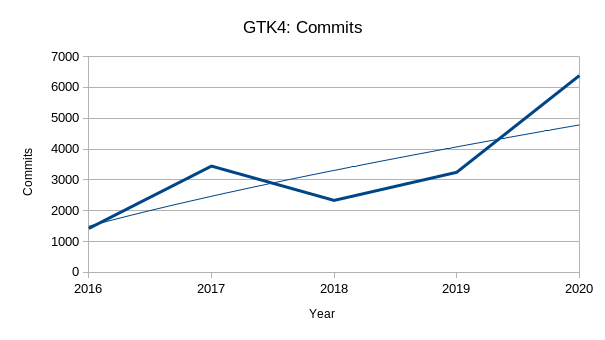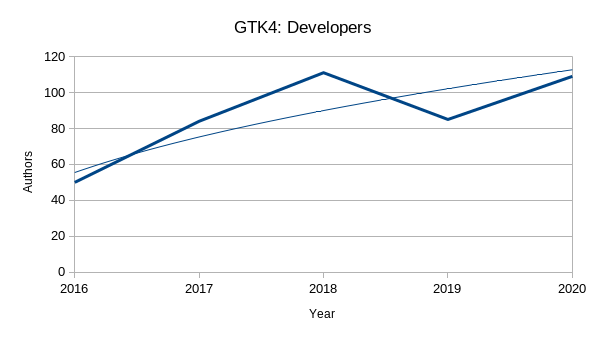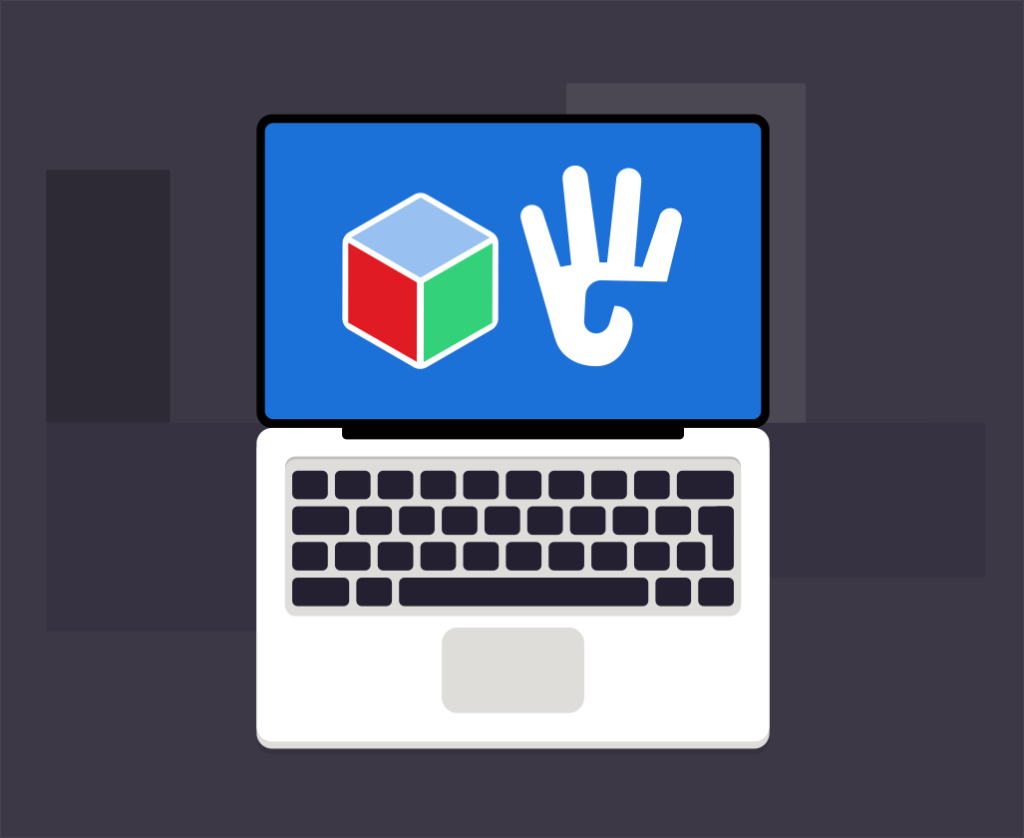GTK 4 has been a colossal, multi-year development endeavor that started in October 2016 and ended in December 2020. Now that the 4.0 release is finally out, it’s time to look back to the incredible amount of work done by hundreds of contributors over these four years.
Back in 2016 we were definitely a bit optimistic on the time table, and thought we would be able to release 4.0 in three years, by the end of 2019. The plan was to start by changing the rendering pipeline of GTK, by moving it to a retained graph of operations that could be submitted to the GPU, as opposed to the immediate mode rendering that we had since the very beginning of the toolkit, and which survived two major API cycles—first by abstracting Xlib drawing commands, and then by moving to Cairo operations. Of course, we also knew we wanted to improve other sub-systems, like input and the windowing system API, to move away from X11-isms and towards a design more in line with the requirements of Wayland (and other windowing systems). What we got, after all was said and done, is a deep redesign of the internals of the toolkit, as well as a different programming model that favors more delegation through ancillary objects, and fewer leaky abstractions and deep type hierarchies; additionally, we pared down the exposed internals, to ensure that the toolkit, and the applications using it, will be more maintainable in the future. The downside is that GTK is less of a “meta toolkit”, whose internal state can be poked at from the outside while expecting to work across multiple releases; that approach was, in the long term, unsustainable given the available resources, and left us unable to optimise or improve the internals of GTK, to the detriment of every user.
We don’t expect the next major development cycle to take this much time, but you know as they say: no plan of operations extends with any certainty beyond the first contact with the main hostile force. The important thing, though, is that we still see potential for improvement; and while we want to celebrate the release of GTK4, as well as everyone who contributed to it, we also want to communicate that the plan outlined in 2016 is still very much in effect. We already started collecting items for a GTK5 development cycle in our GitLab project page, and we plan to have more discussions with various stakeholders for future work in that direction.
Some statistics
Starting from commit 4cce6104 on October 5th, 2016:
- Total commits: 16852
- Developers: 256
- Employers: 10
- Lines added: 1053492, removed: 1053542 (delta: -50)
The most interesting thing is that, for all that work, we ended up with a total of 50 lines of code removed from the existing code base, which includes tests and documentation.
Per year breakdown
| Year | Developers | Commits | Lines added | Lines removed | Delta |
| 2016 | 50 | 1422 | 64014 | 152103 | -88089 |
| 2017 | 84 | 3446 | 186024 | 166198 | 19826 |
| 2018 | 111 | 2332 | 129726 | 140526 | -10800 |
| 2019 | 85 | 3244 | 200476 | 207623 | -7147 |
| 2020 | 109 | 6384 | 470907 | 386761 | 84206 |
 We only had a couple of months in 2016, and the largest effort between October and December was the removal of the deprecated API, and various changes to cope with the renaming from GTK3 to GTK4. Nevertheless, GSK initially landed in November/December. On November 21st, GTK 3.89.1 was released, the first development snapshot of the new GTK 4 API.
We only had a couple of months in 2016, and the largest effort between October and December was the removal of the deprecated API, and various changes to cope with the renaming from GTK3 to GTK4. Nevertheless, GSK initially landed in November/December. On November 21st, GTK 3.89.1 was released, the first development snapshot of the new GTK 4 API.
In 2017, GSK had with multiple iterations over its API: new render nodes were added to implement CSS drawing primitives, and widgets were moved to the GtkSnapshot API from the old Cairo rendering primitives. Additionally, the new clipboard API was introduced, with a stream-based implementation. On March 31st, GTK 3.90.0 was released, followed by 3.92.0 in October.
In 2018, things seem to slow down, but mostly because we moved to GitLab. Suddenly, we had access to a CI pipeline and merge requests, and we became progressively more confident in our development process; lots of work happened in development branches, especially large refactorings, like the renaming of GdkWindow to GdkSurface; the move to GtkGesture objects and the removal of per-widget event signals; or making leaf classes not derivable. GTK 3.94.0 was released in June.
In 2019, development pace picked up once again:
- widget transformations
- layout managers
- constraint layouts
- no more
GtkMenu - scope object for
GtkBuilder GtkTextwidgetGtkNativeandGtkRootinterfaces- per-widget actions
- simplified
GdkSurfacesub-types
Plus, of course, lots of performance and functionality improvements in the rendering pipeline. GTK 3.96.0 was released in May.
Finally, we arrive at 2020:
- new drag and drop API, based on event controllers
- new macOS backend in GDK, replacing the old Quartz one
- new accessibility API, dropping ATK
- no more
GtkContainer - no more
GtkRadioButton - simplified
GdkDeviceAPI - new keyboard shortcuts API
- new expressions and filter models
- new model-based list and tree widgets
GTK 3.98.0 was released in February; and, finally, 3.99.0 in July, as the first true beta towards GTK 4.0.
Developers

Top 20 by commit
| Matthias Clasen | 6519 | (38.7%) | |
| Timm Bäder | 3229 | (19.2%) | |
| Benjamin Otte | 2596 | (15.4%) | |
| Emmanuele Bassi | 1094 | (6.0%) | |
| Carlos Garnacho | 494 | (2.9%) | |
| Daniel Boles | 383 | (2.3%) | |
| Alexander Larsson | 313 | (1.9%) | |
| Jonas Ådahl | 167 | (1.0%) | |
| Chun-wei Fan | 162 | (1.0%) | |
| Christian Hergert | 158 | (0.9%) | |
| Jakub Steiner | 134 | (0.8%) | |
| Piotr Drąg | 132 | (0.8%) | |
| Руслан Ижбулатов | 120 | (0.7%) | |
| Alexander Mikhaylenko | 93 | (0.6%) | |
| Rico Tzschichholz | 78 | (0.5%) | |
| nana-4 | 66 | (0.4%) | |
| Christoph Reiter | 62 | (0.4%) | |
| Tim-Philipp Müller | 60 | (0.4%) | |
| Mohammed Sadiq | 57 | (0.3%) | |
| Olivier Fourdan | 42 | (0.2%) | |
Top 20 by changes
| Matthias Clasen | 620248 | (36.8%) | |
| Benjamin Otte | 466996 | (27.7%) | |
| Timm Bäder | 187516 | (11.1%) | |
| Emmanuele Bassi | 165354 | (9.8%) | |
| Alexander Larsson | 53065 | (3.1%) | |
| Carlos Garnacho | 27227 | (1.6%) | |
| Christian Hergert | 26964 | (1.6%) | |
| Руслан Ижбулатов | 21760 | (1.3%) | |
| Jakub Steiner | 18388 | (1.1%) | |
| Jonas Ådahl | 12824 | (0.8%) | |
| Chun-wei Fan | 12518 | (0.7%) | |
| Daniel Boles | 12371 | (0.7%) | |
| Lapo Calamandrei | 9995 | (0.6%) | |
| Christoph Reiter | 8391 | (0.5%) | |
| Alexander Mikhaylenko | 4936 | (0.3%) | |
| Tim-Philipp Müller | 3932 | (0.2%) | |
| Rico Tzschichholz | 3108 | (0.2%) | |
| William Hua | 2900 | (0.2%) | |
| Jason Francis | 1908 | (0.1%) | |
| Peter Bloomfield | 1727 | (0.1%) | |
As usual, Matthias towers over every other contributor, both in terms of sheer number of commits and in terms of code changes.
Employers
By commit
| Red Hat | 13706 | (81.3%) |
| (Unknown) | 1185 | (7.0%) |
| GNOME Foundation | 1095 | (6.5%) |
| GNOME | 571 | (3.4%) |
| Purism | 93 | (0.6%) |
| Canonical | 84 | (0.5%) |
| Centricular | 75 | (0.4%) |
| Endless | 20 | (0.1%) |
| Collabora | 14 | (0.1%) |
| Intel | 6 | (0.0%) |
| Novell | 3 | (0.0%) |
By changes
| Red Hat | 1415771 | (84.0%) |
| GNOME Foundation | 165355 | (9.8%) |
| (Unknown) | 58220 | (3.5%) |
| GNOME | 33442 | (2.0%) |
| Purism | 4936 | (0.3%) |
| Centricular | 4205 | (0.2%) |
| Canonical | 3347 | (0.2%) |
| Novell | 336 | (0.0%) |
| Intel | 222 | (0.0%) |
| Collabora | 208 | (0.0%) |
| Endless | 121 | (0.0%) |
By contributor
| (Unknown) | 199 | (72.4%) |
| GNOME | 32 | (11.6%) |
| Red Hat | 22 | (8.0%) |
| Endless | 6 | (2.2%) |
| Collabora | 4 | (1.5%) |
| Centricular | 3 | (1.1%) |
| Novell | 3 | (1.1%) |
| GNOME Foundation | 2 | (0.7%) |
| Canonical | 2 | (0.7%) |
| Intel | 1 | (0.4%) |
| Purism | 1 | (0.4%) |
While Red Hat employees affect the most changes, we still have a very large number of contributors from the community—both using their GNOME email address and using their work address even when contributing on a personal level. We also have multiple contributors from various companies in the GNOME and free software at large ecosystems, signalling a healthy community around the project.
Comparing numbers with GTK3 is a bit more tricky:
- the GTK 2 → 3 development phase only took about a year and change, instead of four years
- we were still using the old GNOME infrastructure, which meant fewer, larger patches, and a higher barrier to contribution in the form of Bugzilla
Nevertheless, the amount of contributors more than doubled compared to 2011, with almost three times the amount of unaffiliated contributors.
¹ – Paid staff of the GNOME Foundation.
² – Contributors using a gnome.org email address with no clear employment status.



